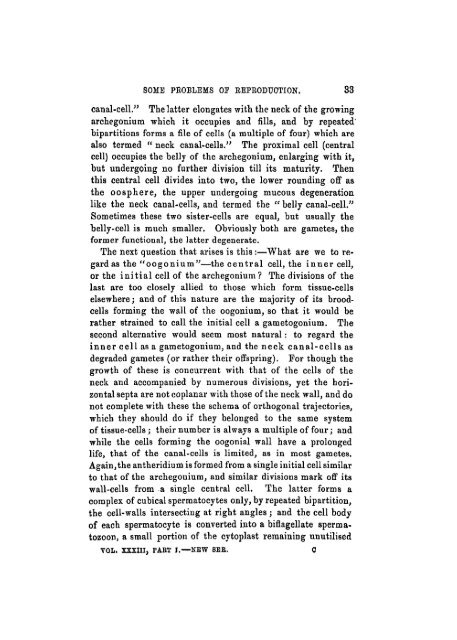Some Problems of Reproduction: a Comparative Study of ...
Some Problems of Reproduction: a Comparative Study of ...
Some Problems of Reproduction: a Comparative Study of ...
Create successful ePaper yourself
Turn your PDF publications into a flip-book with our unique Google optimized e-Paper software.
SOME PEOBLBMS 01 REPRODUCTION. 33<br />
canal-cell." The latter elongates with the neck <strong>of</strong> the growing<br />
archegonium which it occupies and fills, and by repeated'<br />
bipartitions forms a file <strong>of</strong> cells (a multiple <strong>of</strong> four) which are<br />
also termed " neck canal-cells." The proximal cell (central<br />
cell) occupies the belly <strong>of</strong> the archegonium, enlarging with it,<br />
but undergoing no further division till its maturity. Then<br />
this central cell divides into two, the lower rounding <strong>of</strong>f as<br />
the oosphere, the upper undergoing mucous degeneration<br />
like the neck canal-cells, and termed the " belly canal-cell."<br />
<strong>Some</strong>times these two sister-cells are equal, but usually the<br />
belly-cell is much smaller. Obviously both are gametes, the<br />
former functional, the latter degenerate.<br />
The next question that arises is this :—What are we to regard<br />
as the "oogonium"—the central cell, the inner cell,<br />
or the initial cell <strong>of</strong> the archegonium? The divisions <strong>of</strong> the<br />
last are too closely allied to those which form tissue-cells<br />
elsewhere; and <strong>of</strong> this nature are the majority <strong>of</strong> its broodcells<br />
forming the wall <strong>of</strong> the oogonium, so that it would be<br />
rather strained to call the initial cell a gatnetogonium. The<br />
second alternative would seem most natural: to regard the<br />
inner cell as a gametogonium, and the neck canal-cells as<br />
degraded gametes (or rather their <strong>of</strong>fspring). For though the<br />
growth <strong>of</strong> these is concurrent with that <strong>of</strong> the cells <strong>of</strong> the<br />
neck and accompanied by numerous divisions, yet the horizontal<br />
septa are not coplanar with those <strong>of</strong> the neck wall, and do<br />
not complete with these the schema <strong>of</strong> orthogonal trajectories,<br />
which they should do if they belonged to the same system<br />
<strong>of</strong> tissue-cells; their number is always a multiple <strong>of</strong> four; and<br />
while the cells forming the oogonial wall have a prolonged<br />
life, that <strong>of</strong> the canal-cells is limited, as in most gametes.<br />
Again,the antheridium is formed from a single initial cell similar<br />
to that <strong>of</strong> the archegonium, and similar divisions mark <strong>of</strong>f its<br />
wall-cells from a single central cell. The latter forms a<br />
complex <strong>of</strong> cubical spermatocytes only, by repeated bipartition,<br />
the cell-walls intersecting at right angles; and the cell body<br />
<strong>of</strong> each spermatocyte is converted into a biflagellate spermatozoon,<br />
a small portion <strong>of</strong> the cytoplast remaining unutilised<br />
VOL. XXXill, FART I.—NEW SEE. C

















